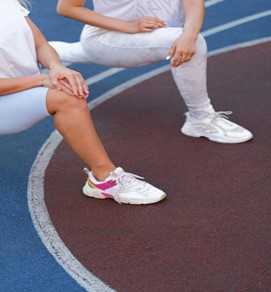House Of cards
Your flat feet could be the reason for your slouched shoulders.
La’mech Young
4/7/20244 min read


I've seen countless clients struggle with poor posture and alignment issues. Often times, the root cause isn't as obvious as you might think. One very common culprit? Flat feet.
The Kinetic Chain
Your body's kinetic chain is the interconnected series of joints and musculoskeletal segments that allow for integrated functional movement patterns. It all starts from the ground up - with your feet serving as the foundation.
When you have adequate arched feet that can stabilize your weight, your knees track properly, your hips remain level, your spine aligns in its natural "S" curve, and your shoulders can sit back and down in their optimal position. It's like a house of cards - as long as the base (feet) is solid, everything stacks up nicely.
But when you have flat feet or fallen arches, that foundation gets dismantled.
The Flat Feet Domino Effect
With flat feet, your ankles roll inwards excessively (overpronation), knocking your knees out of alignment. This internal rotation of the femurs causes your hips to twist under, tilting your pelvis forward into an anterior pelvic tilt.
To compensate for this misalignment of your hips and pelvis, your lower back arches more (hyperlordosis) to maintain your center of mass. But this places extra strain on the spinal erectors and paraspinal muscles.
As you continue traveling up the chain, poor alignment in the lumbar spine causes the thoracic spine to curve outwards, shoulders to roll forward, and head to jut out - the classic "computer posture" look. Chronic forward head and rounded shoulder posture can lead to upper crossed syndrome with tightness in the pecs/subscapularis and weakness in the upper back, neck and shoulder girdle musculature.
So in essence, those flat feet that seemed so harmless are now the catalyst for a chain reaction of postural distortions leaving you with excessive anterior pelvic tilt, hyperlordosis, kyphosis, forward head, and rounded shoulders.I've seen countless clients struggle with poor posture and alignment issues. Often times, the root cause isn't as obvious as you might think. One very common culprit? Flat feet.
The Kinetic Chain
Your body's kinetic chain is the interconnected series of joints and musculoskeletal segments that allow for integrated functional movement patterns. It all starts from the ground up - with your feet serving as the foundation.
When you have adequate arched feet that can stabilize your weight, your knees track properly, your hips remain level, your spine aligns in its natural "S" curve, and your shoulders can sit back and down in their optimal position. It's like a house of cards - as long as the base (feet) is solid, everything stacks up nicely.
But when you have flat feet or fallen arches, that foundation gets dismantled.
The Flat Feet Domino Effect
With flat feet, your ankles roll inwards excessively (overpronation), knocking your knees out of alignment. This internal rotation of the femurs causes your hips to twist under, tilting your pelvis forward into an anterior pelvic tilt.
To compensate for this misalignment of your hips and pelvis, your lower back arches more (hyperlordosis) to maintain your center of mass. But this places extra strain on the spinal erectors and paraspinal muscles.
As you continue traveling up the chain, poor alignment in the lumbar spine causes the thoracic spine to curve outwards, shoulders to roll forward, and head to jut out - the classic "computer posture" look. Chronic forward head and rounded shoulder posture can lead to upper crossed syndrome with tightness in the pecs/subscapularis and weakness in the upper back, neck and shoulder girdle musculature.
So in essence, those flat feet that seemed so harmless are now the catalyst for a chain reaction of postural distortions leaving you with excessive anterior pelvic tilt, hyperlordosis, kyphosis, forward head, and rounded shoulders.
Identifying Flat Feet
There are varying degrees of flat feet, also called overpronation in the fitness world. To check yours, get on a flat surface and look at your arch while standing with equal weight on both feet. If you have little to no arch present, you likely have flat feet.
You can also do a "squat test" - squat down and look at your feet/knees from the side. If your knees cave inwards excessively, that's another good flat feet indicator.
With flat feet, your ankles roll inwards excessively (overpronation)
Fixing Flat Feet and Realigning Posture
So what's the solution if you identify as a flat-footed fallen archer? First and foremost, see a physical therapist or podiatrist to get evaluated and treated properly. They may recommend specific stretches, exercises, orthotics or procedures depending on the severity.
From a personal training perspective, my first focus would be to strengthen the intrinsic foot musculature - especially the fibularis muscles that reinforce the arches. This can be done through towel scrunch exercises, short foot drills, and other foot intrinsic activation work.
Next, I'd address any flexibility restrictions through a well-rounded stretching/mobility program. The usual suspects like tight calves, weak/stretched hamstrings, hip flexors and quads would likely need attention.
Finally, a comprehensive strength training program is crucial to reinforce proper alignment from the ground up - from foot/ankle, to knee, hip, core and shoulder girdle strengthening. This helps reinforce good movement patterns.
It's a process, but through diligent and patient work, you can gradually realign your posture and mitigate issues stemming from flat feet. An ounce of prevention is worth a pound of cure, so don't neglect those arches!
Disclaimer - I'm not a physical therapist or medical professional. I don't diagnose or treat conditions. I simply analyze movement patterns, posture, and imbalances, then draw conclusions to develop personalized exercise programs. With that disclaimer out of the way, let's explore how something as seemingly innocent as flat feet can wreak havoc on your entire kinetic chain.

